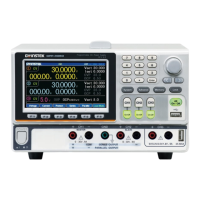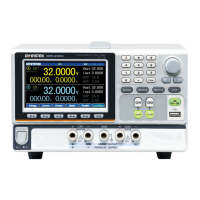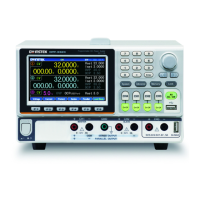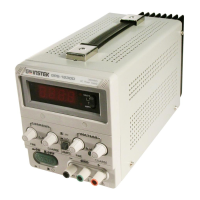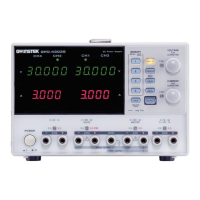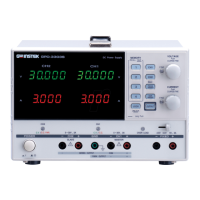Do you have a question about the GW Instek GPP-3323 and is the answer not in the manual?
Icons and their meanings for safe operation and warnings.
General rules and precautions for safe handling and use of the device.
Specific instructions for using the power cord in the United Kingdom.
General description of the GPP series power supply and its capabilities.
Highlights of the main functionalities and specifications of the GPP series.
Detailed explanation of the controls, display, and indicators on the front of the device.
Description of the connectors and ports located on the back of the power supply.
Explanation of how the power supply transitions between CV and CC modes.
Procedures for initial power-on and basic setup of the device.
Instructions on how to properly connect the power supply to a load.
Steps for controlling the output power to the connected load.
How to customize and navigate through different display screens and information.
Settings for configuring the voltage and current output parameters.
How to operate each output channel separately.
Operating multiple channels in series or parallel for increased voltage or current.
Configuration of the power supply to act as a load for testing.
Creating and executing voltage/current waveforms over time.
Setting time delays for pulse outputs or operational sequences.
Real-time monitoring of output parameters and setting conditions for halting operation.
Recording output data for later analysis and saving files.
Using external trigger ports for controlling device functions.
Explanation of the functions assigned to the device's keys.
Managing settings, sequences, and delay data by saving and recalling files.
Resetting the device to its original factory configuration.
Viewing the device's model, firmware, and serial number details.
Configuring interface, language, buzzer, and upgrade options.
Process for updating the device's software to the latest version.
How to use a USB flash drive for software updates and file operations.
Setting up and enabling communication ports for remote operation.
Connecting and configuring the RS-232 interface for remote control.
Connecting and configuring the USB interface for remote control.
Connecting and configuring the GPIB interface for remote control.
Connecting and configuring the LAN interface for remote control.
Understanding the structure and rules of SCPI commands.
Details on different data types used in SCPI commands.
A comprehensive list of available SCPI commands and their functions.
SCPI commands for querying measurement values like voltage and current.
SCPI commands for controlling the device's display settings.
SCPI commands for controlling the output state and protection features.
SCPI commands for setting source parameters and load modes.
SCPI commands for configuring delay functions and sequences.
SCPI commands for setting up monitoring conditions and parameters.
SCPI commands for configuring trigger inputs and outputs.
SCPI commands for querying the device's operational and error status.
SCPI commands for system-level operations like version and configuration.
SCPI commands for system setup, saving, and recalling configurations.
Standard commands adhering to IEEE488.2 protocol.
Understanding the SCPI status register system for instrument control.
Explanation of event registers for tracking operational states.
Defining which bits in event registers can be set.
Reports the status of other registers and message availability.
Reports events like power on, errors, and command completion.
Information on error messages, codes, and handling procedures.
Icons and their meanings for safe operation and warnings.
General rules and precautions for safe handling and use of the device.
Specific instructions for using the power cord in the United Kingdom.
General description of the GPP series power supply and its capabilities.
Highlights of the main functionalities and specifications of the GPP series.
Detailed explanation of the controls, display, and indicators on the front of the device.
Description of the connectors and ports located on the back of the power supply.
Explanation of how the power supply transitions between CV and CC modes.
Procedures for initial power-on and basic setup of the device.
Instructions on how to properly connect the power supply to a load.
Steps for controlling the output power to the connected load.
How to customize and navigate through different display screens and information.
Settings for configuring the voltage and current output parameters.
How to operate each output channel separately.
Operating multiple channels in series or parallel for increased voltage or current.
Configuration of the power supply to act as a load for testing.
Creating and executing voltage/current waveforms over time.
Setting time delays for pulse outputs or operational sequences.
Real-time monitoring of output parameters and setting conditions for halting operation.
Recording output data for later analysis and saving files.
Using external trigger ports for controlling device functions.
Explanation of the functions assigned to the device's keys.
Managing settings, sequences, and delay data by saving and recalling files.
Resetting the device to its original factory configuration.
Viewing the device's model, firmware, and serial number details.
Configuring interface, language, buzzer, and upgrade options.
Process for updating the device's software to the latest version.
How to use a USB flash drive for software updates and file operations.
Setting up and enabling communication ports for remote operation.
Connecting and configuring the RS-232 interface for remote control.
Connecting and configuring the USB interface for remote control.
Connecting and configuring the GPIB interface for remote control.
Connecting and configuring the LAN interface for remote control.
Understanding the structure and rules of SCPI commands.
Details on different data types used in SCPI commands.
A comprehensive list of available SCPI commands and their functions.
SCPI commands for querying measurement values like voltage and current.
SCPI commands for controlling the device's display settings.
SCPI commands for controlling the output state and protection features.
SCPI commands for setting source parameters and load modes.
SCPI commands for configuring delay functions and sequences.
SCPI commands for setting up monitoring conditions and parameters.
SCPI commands for configuring trigger inputs and outputs.
SCPI commands for querying the device's operational and error status.
SCPI commands for system-level operations like version and configuration.
SCPI commands for system setup, saving, and recalling configurations.
Standard commands adhering to IEEE488.2 protocol.
Understanding the SCPI status register system for instrument control.
Explanation of event registers for tracking operational states.
Defining which bits in event registers can be set.
Reports the status of other registers and message availability.
Reports events like power on, errors, and command completion.
Information on error messages, codes, and handling procedures.
| Output Voltage | 0 - 32V |
|---|---|
| Output Channels | 3 |
| Voltage Resolution | 10 mV |
| Current Resolution | 1 mA |
| Operating Temperature | 0°C to 40°C |
| Output Current | 0 ~ 3A |
| Load Regulation | ≤0.01% + 3mV (Voltage); ≤0.02% + 3mA (Current) |
| Line Regulation | ≤0.01% + 3mV (Voltage); ≤0.02% + 3mA (Current) |
| Ripple and Noise | ≤1mVrms |
| Display Type | LCD |
| Interface | USB, RS-232 |
| Voltage Accuracy | ±0.05% + 10mV |
| Storage Temperature | -20°C - 70°C |
